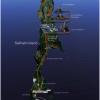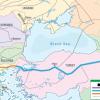Baku, Tbilisi, Ceyhan
The Baku, Tbilisi, Ceyhan (BTC) pipeline is a large diameter, long distance pipeline (1,768 Km) developed by BP as the operator to transport crude oil from the Azeri-Chirag-Guneshli oil field in the landlocked Caspian Sea to a marine shipping terminal (Haydar Aliyev) on the south-eastern Mediterranean coast of Turkey. I was engaged by Streicher of the Joint Venture Streicher, Haustadt & Timmerman, Gunsayil, Alarko (STA Joint Venture for LOT ‘B’ in Turkey), contracted to BOTAS, to troubleshoot the project, which had fallen behind schedule and had significant cost overruns. Lot ‘B’ was 465 km and the longest section of the 1076 km that crossed Turkey, it traversed plains and mountainous areas from Erzurum to Sivas, with elevations up to 2830 metres and had been under construction for 18 months when I arrived in April 2004. The problem was, like most pipelines, that efforts to maintain welding production at all costs had dominated decisions and as a consequence control had been lost with an ever-increasing distance between front and back-end operations. Over 300 km of pipe had been welded above ground but only a little over 40 km had been lowered-in and buried and very few crossings completed. To make matters worse, much of the welded sections of pipeline sitting above ground had been left to the mercy of the winter, which, after the heavy snowfalls and thaw period, resulted in large sections of pipeline slipping down the steep slopes, in some instances the distance exceeded several 100’s of metres, causing a vast amount of serious coating damage; all additional and costly work that could have been prevented.
I was engaged by Streicher of the Joint Venture Streicher, Haustadt & Timmerman, Gunsayil, Alarko (STA Joint Venture for LOT ‘B’ in Turkey), contracted to BOTAS, to troubleshoot the project, which had fallen behind schedule and had significant cost overruns. Lot ‘B’ was 465 km and the longest section of the 1076 km that crossed Turkey, it traversed plains and mountainous areas from Erzurum to Sivas, with elevations up to 2830 metres and had been under construction for 18 months when I arrived in April 2004. The problem was, like most pipelines, that efforts to maintain welding production at all costs had dominated decisions and as a consequence control had been lost with an ever-increasing distance between front and back-end operations. Over 300 km of pipe had been welded above ground but only a little over 40 km had been lowered-in and buried and very few crossings completed. To make matters worse, much of the welded sections of pipeline sitting above ground had been left to the mercy of the winter, which, after the heavy snowfalls and thaw period, resulted in large sections of pipeline slipping down the steep slopes, in some instances the distance exceeded several 100’s of metres, causing a vast amount of serious coating damage; all additional and costly work that could have been prevented.
My job, with Alarko now taking the lead and Streicher bowing ou of the projectt, was to take stock of the situation, do a complete gap analysis, re-plan and re-resource the project and demonstrate a reliable completion date, which was a difficult task given the sporadic nature of construction, skipped sections etc; but in accordance with my planning completion was achieved in October 2005.






